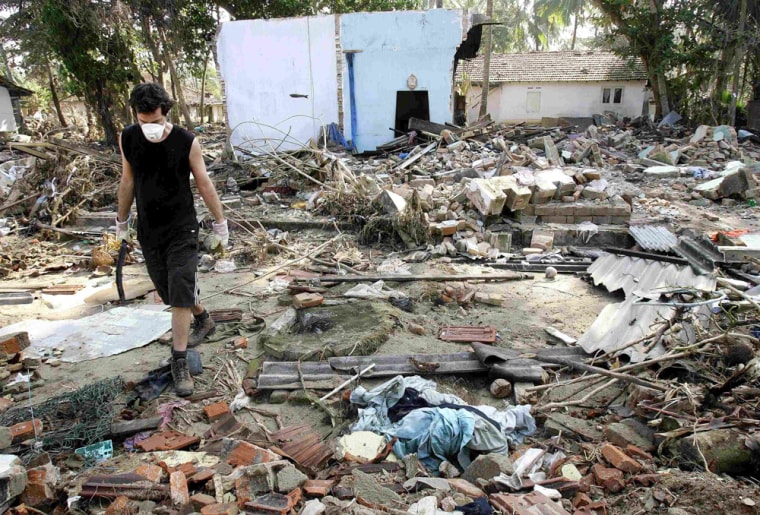The absolute devastation is overwhelming. Houses have been reduced to splinters of wood and chunks of brick and mortar. Vehicles lie twisted around palm trees, or sit upside down in bays hundreds of yards from land. But the most striking indication of what was lost along the Sri Lankan coastline is what you don't see: people.
There's an eerie emptiness to the hardest-hit areas.
The odd survivor salvages what little remains, but so much of this once-vibrant waterfront is devoid of humans.
Here and there are tiny signs of recovery — a few tufts of new grass sprout up amid the brick and sand.
But, aside from the lapping of ocean waves against pristine sandy beaches and the raucous caw of crows, who have found an abundance of food in the debris, silence predominates.
The reason is twofold: More people died on the coast than survived, and the Sri Lankan government is now banning reconstruction within 300 yards of the high-water mark. The ban is intended to reduce the number of casualties should another tsunami strike.
It's a stark contrast to the scene just a few blocks inland, where homes were inundated but not destroyed, and where many more people survived. There, backhoes and dump trucks navigate the narrow dirt lanes, removing piles of rotting seaweed, clothing and other detritus left by the 20-foot-high surge of water that poured through the streets on Dec. 26
‘We were helpless’
Tales of tragedy and woe pour from survivors, but two weeks after the tsunami, there are few tears left.
The stoicism and apparent resilience of the people who lived through this nightmare are awe-inspiring.
Digging through the debris that remains of his home, 62-year-old Abdul Raheem talked about how he and his family were flushed out of their home by the sea.
"We were helpless. We grabbed for trees or ran for higher ground. That's all we could do."
Raheem lost his daughter, son-in-law and a grandchild. His wife and a 12-year-old grandson survived.
The boy wandered about the rubble that remains of their house, seemingly with no purpose. Abdul is pulling wood from the pile, while his wife is scavenging clothing.
He plans to build a small cottage for the three of them but has no idea what he'll do for money.
As we were about to leave, he beckoned us over to a rickety wooden cart. His hands roamed over the worn frame. Before the deluge he hauled goods in the back. It was pulled by two fine bullocks, which were washed away.
"My cart is OK, but what can I do without the bullocks?" At $500 a pair, he has no hope of starting business again.
Seeing his plight, I promised myself I’ll return the next day, with a gift of money for at least one bull.
‘It was a killer, or you survived and walked away’
The doctors we speak with are astounded at what they've seen here.
There are hundreds of doctors and nurses here now, like the busload of Buddhists who kindly offered us a ride after we got stranded at dusk, in the rain, in another eastern village called Potteville.
They had come down from Colombo — a 14-hour journey — to offer their services over the weekend, before returning to work on Monday.
Many others have come from around the world to work with the relief effort.
We met three Americans from an Oregon group called Northwest Medical Teams.
A 72-year-old pediatrician, Neil Buist, was dragging desks around to cobble into an examination table.
He, his wife, Dr. Susan Winter, and nurse Mark Bloomfield have now been here about a week.
After examining a listless 12-year-old orphan wracked with pneumonia, he speculated on why there were far fewer injuries from the tsunami than had been expected.
"It's blown everybody away because we've been wondering where they all are. I think it was a killer — or you survived and walked away."
But he believes that many of those who walked away are still hurting.
Race to recover before attention shifts elsewhere
Buist, a grizzled tower of a man, engages his patients with the warmest of bedside manners, but underneath, he's worried about long-term health issues among survivors.
"Half the people coming into the clinic have signs of an overlay of anxiety or depression. You look at their faces, and a lot are absolutely set. There's no emotion in their face, it's just shell-shocked."
Buist and others expect long-term counseling may not be an option in the developing nations that were so badly hit by the waves.
The priorities of cash-strapped governments will be to get the millions of displaced back into homes and to work again. They will hope to do as much as possible before the focus of global attention shifts elsewhere.
A day later, my attention has shifted, to another story, in another location. I remember too late my promise to myself to help out Abdul Raheem and his family, and I wonder if, and hope that, they'll make it.
